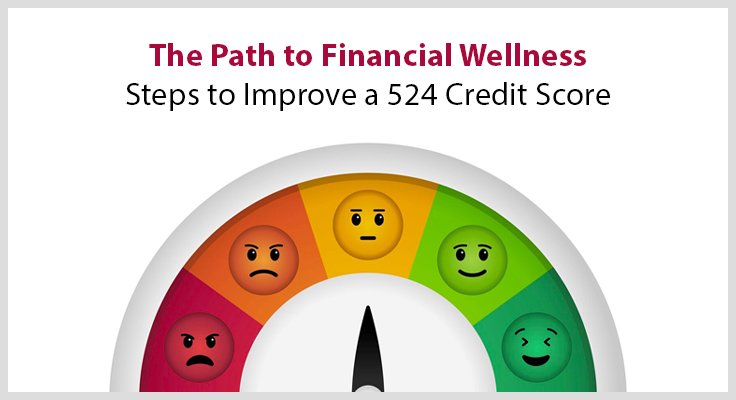Is your credit score stuck at 524, holding back your financial potential? Don’t worry—you’re not alone, and this situation is far from permanent. While a score of 524 falls into the poor range (300 to 629), the good news is that it can be improved with the right strategies. And no, it doesn’t have to feel like climbing Mount Everest!
This guide will provide you with actionable steps to elevate your score from 524 to a healthier financial standing. Whether you’re just starting out, rebuilding after financial setbacks, or seeking to unlock better financial opportunities, these tips are designed to help you achieve financial wellness. Let’s get started on your journey to a stronger credit score.
Why Does a 524 Credit Score Matter?
Think of your credit score as a report card for your financial habits, graded by institutions like lenders, landlords, and even some employers. With a credit score 524, you’re facing challenges like:
- Higher interest rates on loans or credit cards
- Difficulty securing approvals for credit cards, housing, or even cell phone plans
- Smaller credit limits, which can mean facing the challenge of making every dollar stretch further
But your credit score isn’t a life sentence—it’s a solvable problem. Improving your score opens doors to new opportunities, such as qualifying for a rental apartment, landing a lower mortgage rate, or even securing a job that requires financial responsibility. The sooner you start, the faster those opportunities multiply.
Steps to Improve a 524 Credit Score
1. Check Your Credit Report for Errors
Your first step? Pull your credit report from all three major credit bureaus—Experian, Equifax, and TransUnion. You’re entitled to one free report annually via AnnualCreditReport.com.
Here’s what you should look for:
- Incorrect balances or payments
- Accounts you don’t recognize (potential identity theft!)
- Errors in personal information, like your name or address
If you spot any errors, don’t panic. File a dispute directly with the bureau(s) reporting the mistake. Correcting inaccurate negative marks can give your score an easy bump.
2. Pay Bills on Time, Every Time
Behind every good credit score lies one secret weapon—consistent, on-time payments. Payment history makes up 35% of your credit score, so missing a payment is a surefire way to drag it down.
- Pro Tip: Set up autopay or calendar reminders to stay on track. Even catching up on late payments quickly demonstrates to creditors that you’re serious about financial responsibility.
3. Reduce Credit Card Balances
Carrying too much credit card debt compared to your limit significantly impacts your score. This ratio—known as your credit utilization rate—should ideally stay below 30%.
For example, if your credit limit is $1,000, aim to keep your balance under $300.
- Pay more than the minimum due each month to chip away at balances faster.
- If possible, increase your credit limits (but don’t run up more debt!).
Low utilization shows lenders you aren’t overexerting your finances.
4. Consider Secured Credit Cards
If your current credit card applications are getting denied, it might be time to try a secured credit card. These cards work by requiring a cash deposit upfront as collateral—think of it as credit score rehab.
Use your secured card strategically. Make small purchases and pay them off in full every month. Over time, consistent usage builds a positive payment history, which is key to credit recovery.
5. Limit New Credit Applications
Applying for credit too frequently sends lenders a red flag that you’re desperate for money. Plus, each credit inquiry slightly dings your score.
Do this instead:
- Only apply for credit cards or loans when necessary.
- Use prequalification tools that perform “soft” credit inquiries (these won’t affect your score).
Patience is your best friend—steady improvements over time are better than short-term mistakes.
6. Diversify Your Credit Mix
Your credit score likes variety. A healthy balance of installment loans (like auto loans or mortgages) and revolving credit (like credit cards) shows you can responsibly handle different types of debt.
If you only have credit cards, consider adding a small personal loan to diversify your credit mix—but stick to manageable amounts with low interest rates.
Example:
- A $700 personal loan, managed and repaid responsibly, could boost your credit score for business credit over time.
7. Keep Old Accounts Open
Older credit accounts carry historical weight on your report. Closing them shortens your credit history, which impacts about 15% of your score.
Unless an account has an annual fee you can’t justify, leave it open—even if you’re not actively using it.
8. Negotiate with Creditors
Think a late payment or defaulted account is stuck on your report forever? Not necessarily. Some creditors offer “pay-for-delete” agreements, allowing negative marks to be removed in exchange for paying off your debt.
Reach out to your creditor or collection agency, explain your willingness to settle the debt, and inquire if they’d consider removing the account from your credit report. While not guaranteed, it’s worth the effort.
9. Be Patient (And Persistent)
Improving a credit score—especially one starting at 524—requires time and discipline. Minor improvements, like reducing balances, show effects in months, while major efforts, like building payment consistency, take longer.
Think of it as a marathon, not a sprint. Stay persistent, celebrate small wins, and trust that your efforts will pay off.
Staying on Track Over the Long Term
Once your score begins to climb, the key is to maintain healthy habits. Here are some quick tips to keep progress rolling:
- Regularly check your credit report for updates/errors.
- Continue paying bills on time, aiming for 100% on-time records.
- Stay under 10–30% credit utilization for the best results.
Credit improvement isn’t necessarily exciting, but the doors it opens—better loan rates, approvals for housing, and even better insurance premiums—are worth the effort.
Also Read: The Complete Checklist for Getting a Business Loan with EIN Only





















